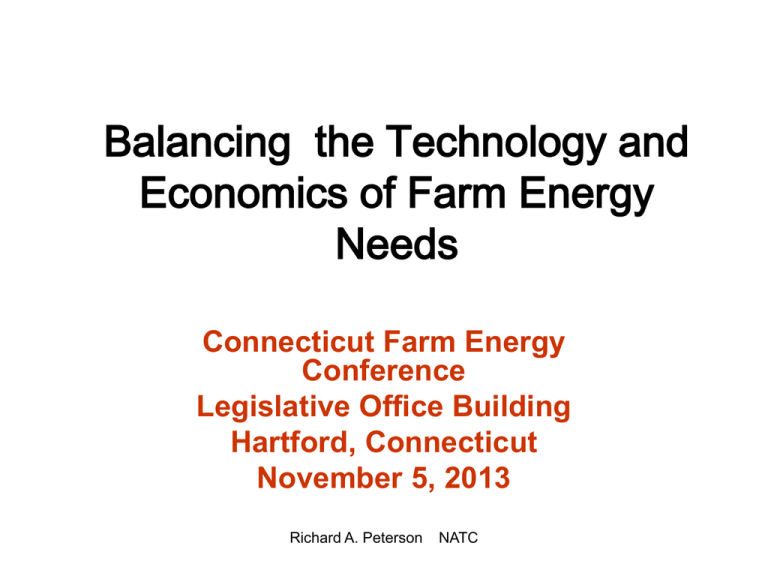Balancing the Technology and Economics of Farm Energy Needs
advertisement

Balancing the Technology and Economics of Farm Energy Needs Connecticut Farm Energy Conference Legislative Office Building Hartford, Connecticut November 5, 2013 Richard A. Peterson NATC A General Look at Energy use in Agriculture • Agriculture is Energy Dependent • Primary Energy Drivers – Electricity – Diesel Fuel/Gasoline/Biofuels – Fuel Oil/Natural Gas/Propane – Solar/Wind/Methane/Biomass/Other Renewables Richard A. Peterson NATC Uses of Energy on Farms • • • • • • • • • • Soil preparation Planting Crop Care Commodity Harvest Materials Handling/On Farm Processing Environmental Control/Livestock Comfort Storage Systems Lighting Heating Transportation Richard A. Peterson NATC Current Farm Energy Consumption • Direct energy – diesel, gasoline, LP gas, natural gas, and electricity • Indirect energy – fertilizers and pesticides Richard A. Peterson NATC Breakdown of Farm Energy Use Across the US Total Energy Consumed in US Farms in 2002 Total = 1.7 Quadrillion BTUs Natural Gas 4% LP Gas 5% Fertilizers 28% Pesticides 6% Gasoline 9% Electricity 21% Diesel 27% Source: Prof. John Miranowski, Iowa State University Richard A. Peterson NATC Direct Energy Expenditure per Dollar Expenditure and Output in 2002: Major Crops 0. 058 Corn 0. 048 0. 053 0. 052 Soybean 0. 052 Cotton 0. 060 0. 070 0. 069 Wheat 0. 064 Rice 0. 092 0 0.02 0.04 0.06 0.08 0.1 Direct Energy Expenditure per dollar of Total Expenditure Direct Energy Expenditure per dollar Output Source: Prof. John Miranowski, Iowa State University Richard A. Peterson NATC Direct Energy Expenditure per Dollar Expenditure and Output in 2002: Livestock Hogs Poultry Dairy 0.032 0.017 0.028 0.023 0.040 0.038 Beef cattle 0.000 0.078 0.020 0.020 0.040 0.060 0.080 Direct Energy Expenditure per dollar of Total Expenditure Direct Energy Expenditure per dollar Output Source: Prof John Miranowski, Iowa State University Richard A. Peterson NATC 0.100 Direct Energy Expenditure per Dollar Expenditure and Output in 2002: Speciality Crops 0 .0 2 9 0 .0 2 1 Fruits/tree nuts 0 .0 3 1 0 .0 2 1 Vegetables 0 .0 3 4 0 .0 2 7 Nurseries 0 0.02 0.04 0.06 0.08 Direct Energy Expenditure per dollar of Total Expenditure Total Energy Expenditure per dollar output Source: Prof John Miranowski, Iowa State University Richard A. Peterson NATC 0.1 Is Farm Energy Use Increasing? • Agricultural production is growing at an average rate of 2% per year • However, Energy inputs have remained relatively flat over the last 30 years • Farm operators have increased energy efficiency Richard A. Peterson NATC A quick look at Connecticut agriculture • Farm numbers have increased by 733 farms or 17.5% between 2002 and 2007. • Farm acreage has increased 13.6% in that same 5 year period • However, the average acreage per farm is down slightly • The total value of farm commodities has increased 17.2% between 2002 and 2007 Source: 2007 Census of Agriculture Richard A. Peterson NATC The Top 9 of 25 Connecticut Ag Commodities Represent more than 76% of total commodity value • • • • • • • • • Greenhouse/Nursery Dairy Chicken (eggs) Aquaculture (clams & oysters) Sweet Corn Cattle and calves Apples Tobacco Hay Richard A. Peterson 44.2% 12.7% 8.7% 3.2% 2.0% 1.6% 1.4% 1.3% 1.1% 76.2% NATC How can Connecticut Farm Operators Assess and Improve Energy Efficiency? • Get an energy audit (conducted by agricultural professionals) • Prioritize energy efficiency improvement opportunities and set goals for implementation Richard A. Peterson NATC Why Conduct and Energy Audit? • Energy audits provide a decision making tool to help farm operators assess appropriate energy conservation measures • Energy audits provide a clear picture of a farm’s energy use and the pattern of usage by day and by season • Audits are sometimes required as part of energy related grant applications, such as the USDA REAP grant program. Richard A. Peterson NATC Thinking About a Renewable Energy System? An energy audit will provide valuable information about energy use patterns on your farm. This information is very important as you assess the economics of a renewable energy system. Richard A. Peterson NATC What are Energy Utilization Indices? • Energy Utilization Indices (EUIs) refer to the amount of energy used to accomplish a certain activity or process. • EUIs for farms are stated in various ways: • kWh/unit of production (cwt of milk, bu. of grain) • kWh/animal unit (cow, feeder pig, 100 chickens) Richard A. Peterson NATC What Are Energy Conservation Measures? • Energy Conservation Measures refer to equipment or operational measures that will increase efficiency and save energy Richard A. Peterson NATC The Value of Knowing EUIs • Determining farm EUIs provides benchmarking data related to similar farms in the same region • Having valid EUI data helps farm operators prioritize energy efficiency upgrades Richard A. Peterson NATC How Dairy Farms Use Energy Information Gathered in an Energy Audit Northeast Agriculture Technology Corp. Richard A. Peterson Ithaca, NY NATC Major Energy use Functions on a Dairy Farm • • • • Milk Harvest* Milk Cooling* Lighting* Air Circulation* and Ventilation • Washing and Water Heating* • Manure Handling • Water Pumping • Feed Handling • Compressed Air *Indicates uses where significant energy savings is possible Richard A. Peterson NATC WHERE IS ELECTRICITY USED ON DAIRY FARMS? Summary of electric energy use on a typical dairy farm Electric water heating 5% Miscellaneous 2% Feeding equipment 3% Milking 18% Manure handling 5% Lighting 17% Milk cooling 26% Ventilation 24% Source: NATC, Ithaca, NY Richard A. Peterson NATC Freestall vs. Tie Stall Operations • Freestall operations Feeding Equipment 1% Manure Handling 4% Misc. 1% • Tie stall operations Vacuum Pumps 17% Feeding Equipment 7% Ventilation 21% Ventilation 22% Milk Cooling 27% Lighting 26% Lighting 17% Electrical Water Heating 2% Richard A. Peterson NATC Manure Handling 3% Misc. 1% Vacuum Pumps 18% Milk Cooling 23% Electrical Water Heating 10% Renewable Energy Systems Farms make a good fit Richard A. Peterson NATC Key Issues of On-Farm Biogas Generation Richard A. Peterson NATC Anaerobic Digesters are common worldwide • There are 6 to 8 million low technology farmbased digesters used to provide biogas for cooking and lighting • The worldwide trend is toward larger, more sophisticated systems with advanced process control. • The European Union countries are most advanced in anaerobic digester applications Richard A. Peterson NATC Farm Biogas Plants In The European Union Source: AD NETT, European Anaerobic Digester Network Richard A. Peterson NATC Large Scale Agricultural AD in Germany Richard A. Peterson NATC Anaerobic Digesters in the US • The first farm based digester was built at McCabe Farms in 1972 • McCabe farms is a hog farm bordering the Town of Mt Pleasant, IA • Odor control was the driving reason for building the digester • Vertical plug flow/natural gas used to heat • Still operational – all biogas is flared Richard A. Peterson NATC Dairy Anaerobic Digesters Elsewhere in the US • Anaerobic digester interest among US dairymen grew during the energy crisis of the 1970s. • Numerous digesters were built , but most failed because of high operating costs, and inadequate technology. • There is a great resurgence of interest and activity in many dairy states Richard A. Peterson NATC Why Greater Interest in Manure Digesters? 1. Need for controlling odor & managing waste (larger farms) 2. Higher prices for energy 3. Government (USDA) grants & loans 4. Media articles on farms producing green power 5. Increased cost for fertilizer (manure used as a substitute) 6. Firms looking to invest in biogas facilities & sell power 7. Carbon/renewable energy credits Richard A. Peterson NATC Dealing With Volumes of Waste 1,200 lb. cow produces her own weight in manure every 25 days* 150 lb. finishing pig produces its own weight in manure every 15 days* * 98 lbs of manure produced per day A herd of 500 cows produces 49,000 lbs. of manure per day * 9.8 lbs of manure produced per day. A herd of 500 finishing pigs produces 4,900 lbs. of manure per day Richard A. Peterson NATC Components of a Biogas System Digester: Consists of a closed chamber or lagoon Anaerobic microbes (absence of oxygen) To work correctly, it must be managed. Consistent input, keep within acid/base tolerances, etc. Richard A. Peterson NATC Components of a Biogas System Solids Separator: Squeezes out liquid to create a dry bedding for cows. Richard A. Peterson NATC Components of a Biogas System Richard A. Peterson NATC Biogas Production System Consider the additional expense, number of moving parts, maintenance and management needed to turn gas into electricity. Richard A. Peterson NATC Economics – Two New York Dairies Sunny Knoll Dairy in New York (1,400 cows) Patterson Dairy in New York (1,000 cows) Digester: Site Work Engineering Design Concrete Digester Miscellaneous Energy Conversion: Engine-Generator Elec., Controls, Plumb. Biomass Use Bldg. Family Labor Digester: $40,000 105,000 350,000 27,000 $350,000 145,000 30,000 Site Work Engineering Design Concrete Digester Miscellaneous Energy Conversion: Engine-Generator Elec., Controls, Plumb. Biomass Use Bldg. $7,500 2005 Constr. Cost $1,084,500 Family Labor Solid-liquid separation Building Separator 2004 & 05 Constr. Cost Richard A. Peterson NATC $62,723 99,532 495,930 31,893 $200,000 317,476 51,601 $68,553 127,775 53,147 $1,508,630 More Farm Renewable Energy Opportunities • Solar and Wind • Biomass Production • Biofuels Richard A. Peterson NATC Gary Menard Dairy Farm Mooers, NY A 12.6 kW Solar Photovoltaic System With Zomeworks® Trackers Richard A. Peterson NATC Cost Details Menard Solar System Total Cost (with tracker) NYSERDA Incentive USDA Grant Menard Cost Cost/kWh (34 months) $124,647 $ 50,400 $ 31,161 $ 43,086 $ 0.41/kWh Note: Solar tracking system can increase annual output by up to 40%. Richard A. Peterson NATC A 5.5 kW solar system with NOVAR® Tracker Currently producing 50% more than a similar system with a fixed array. Richard A. Peterson NATC Lifetime Output and Economics Shows lifetime output since May 2006 2006 2007 2008 2009 10 kW Consistently generates approx. 7,000 kWh per year Value: 7,000 kWh x $.09/kWh = $630 per year Simple payback: Installed cost = $50,000 With 30% tax credit, drops to $35,000 Yearly output = $630 worth of energy Lessons Learned: Inverter destroyed by lightning Output slightly less than ratings Takes 55.5 years to pay off Cost of elec. generated = 74 cents/kWh Richard A. Peterson NATC Summary • Farms are energy intensive • Energy Conservation and Efficiency Improvements are a logical first step in a long range energy management plan • Renewable energy systems are compatible with farm operations • Few renewable energy systems are economically feasible without incentives Richard A. Peterson NATC Summary • Renewable energy systems on farms should be considered only after all practical energy efficiency upgrades and energy conservation measures have been adopted • Reducing farm load on rural electric distribution systems is beneficial to utilities and customers alike • Renewable energy systems producing electricity on farms can reduce stress on rural distribution lines • The economics of renewable energy systems will improve over time. Richard A. Peterson NATC Thank you for your time. Richard A. Peterson NATC









